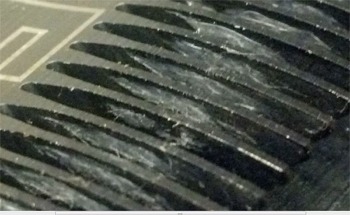by Jeff Andrews, Northern Tails Sharpening
Blade plaque is the “stuff” that sticks to the insides of clipper blade teeth. Most groomers pay little attention to it. Actually it is something they need to remove and keep off as part of regular blade cleaning.
What is it made of? Blade plaque is a combination of many things all organic in nature. Dander, hair pieces, mole spores, soap scum, insect residue and eggs and anything else that might be in the coat. Even wet shaving can contribute to plaque. Blade plaque builds up from a foundation of moisture and starts layering itself to a point where you can’t get a blade through coat. I was taught at grooming school in the Eighties to make sure this stuff gets cleaned off because it slows the blade. It made sense to me! It gets worse. Blade plaque is well-suited to providing food and shelter for bacteria and viruses.
I bartered a groom with a microbiologist at our local college for her assistance. The plan was to bring her a blade for analysis. The results were shocking.
She took a sample of the media from the blade teeth and layered it vertically and horizontally. Her group did gram stains and cultures from every part of the media. Bacteria was found in everywhere in the plaque.
I asked if this bacteria can live in every part of this media, what about viruses? She said without hesitation that viruses could thrive in this organic media. She didn’t test for viruses because it wasn’t part of the bartered job.
What about spray disinfectants? Over- the-counter spray disinfectants for groomers contain a few common disinfectants, such as Phenylphenol, Triclosan and Ethanol 2-butoxy. They all do a good job but they are “surface disinfectants,” not contact killers like bleach.
Bleach and some other very controlled disinfectants available to vets are contact killers. Surface disinfectants work over time. If you read the label of disinfectant your using, it will tell you how long the product must remain wet on the blade for it to work.

Will spray disinfectants work on blade plaque? Because they do a good job of controlling blade surface microbes on your blades, I doubt they get into the layers of blade plaque possibly hosting harmful microbes. Your spray disinfectant may control microbes on the surface of the blade plaque, but when you complete a pet and start another, the hair is going to scrape that same top layer of blade plaque away exposing fresh media underneath it. If there are any microbes in the fresh media chances increase that you could spread it to another dog. Common bacteria may not hurt anything, it is everywhere in your work environment. However, what if Parvo virus, or Kennel Cough are present in the media?
So what do we do with blade plaque? You clean it off. As a groomer it is your job to clean your blades at the end of each workday or between pets.
Blade plaque build up only happens from a lack of regular proper cleaning. Coolants claiming to “clean” are worthless in this matter. What do they clean?
There are methods to effectively clean your clipper blades easily and quickly.
The most basic method requires a toothbrush soaked in blade wash. Hold your blade and run the toothbrush between the teeth of your blades. Make sure the wash includes contains a disinfectant. If you clean your blades regularly and properly between pets or at least at the end of each workday, you will never see blade plaque.
Make sure there is nothing sticking to the inside of the teeth on your blades. There are several other ways to clean them tool. For example, you can use a power washer in your tub or ultrasonic cleaners, etc.
Whichever method fits you is fine. Just be sure to keep blade plaque from building up on your blades. One day it could benefit you one day down the road by preventing something from spreading through your shop.
Have a great day grooming and read those labels! ■



